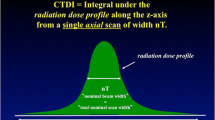Abstract
In this work, we define the optimal dose as a combination of the projections on orthogonal axes of the absorbed dose and an integer multiple of the integral dose. Here, we show that such optimal dose minimizes the mean square of the total absorbed dose subject to certain conditions of integration. We prove that there is a unique minimizer.

Similar content being viewed by others
References
Balog, J., et al.: Dose computation for a one-dimensional collimator. In: Proceedings of the XII International Conference on the Use of Computers in Radiation Therapy, pp. 323–326. Medical Physics Publishing, St. Louis (1997)
Carol, M., et al.: Initial clinical experience with the peacock intensity modulation of a 3-D conformal radiation therapy system. Stereotact. Funct. Neurosurg. 66, 30–34 (1996)
Deasy, J.O.: Multiple local minimums in radiotherapy optimization problems with dose volume constraints. Med. Phys. 1157–1161 (1997). doi:10.1118/1.598017
Fang, G., et al.: Software system for therapy prototype. In: Proceedings of the XII International Conference on the Use of Computers in Radiation Therapy, pp. 332–334. Medical Physics Publishing, St. Louis (1997)
Shepard, D.M., et al.: Optimizing the delivery of radiation therapy to cancer patients. SIAM Rev. 41(4), 721–744 (1999)
Niemierko, A., et al.: Analysis and optimization of the integral dose in radiotherapy of neoplasms using the “box” technique. Nowotwory 39(1), 60–64 (1989)
Author information
Authors and Affiliations
Corresponding author
Additional information
Communicated by Alberto D’Onofrio.
Appendices
Appendix A: Proof of Lemma 3.1
Integrate the function d with respect to x 1,…,x i−1, x 1+i ,…,x n .

by Equality (1).
Appendix B: Proof of Lemma 3.2
We expand the function d 2.

Integrate with respect to x 1,…,x n .

Appendix C: Proof of Theorem 3.1
By Equality (2) and Lemma 3.1, by integrating the difference f−d with respect to all x’s but x i we get zero.
Multiply by p i , and add up with respect to the index i.
Integrate with respect to x i .

Integrate with respect to x i equality (3), and multiply by a constant.

Subtract this equality from Equality (4).

Multiply by 2. Suppose that the function f 2 is integrable, and add the integral of the sum of the squares of the function d and the difference (f−d).

Therefore,
Equality occurs only if the function f is equal to the function d.
Rights and permissions
About this article
Cite this article
Martinez-Morales, J.L. The Minimization of the Quadratic Mean of an Integral Dose. J Optim Theory Appl 157, 513–519 (2013). https://doi.org/10.1007/s10957-012-0153-z
Received:
Accepted:
Published:
Issue Date:
DOI: https://doi.org/10.1007/s10957-012-0153-z




